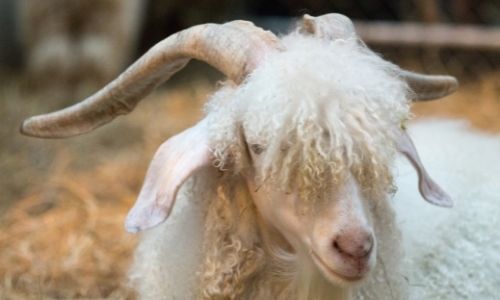I was out to see another goat-owning friend at his homestead the other day, and while I’ve only ever kept mine as companions, he harvests the fiber from his to sell.
I wasn’t at all familiar with the process or the market, so it was interesting to hear all about it from him.
I learned a lot of things—not least how profitable the venture can be! I knew that goats were kept for their fiber, but not as much as sheep were.
I knew that sheep hair was called wool, so I asked if goat hair has a name.
So, what is goat hair called?
Goat hair is called mohair—if it comes from an Angora goat. For the most part, the simplest way to refer to goat hair is as fiber. The speciality name is mohair, but there are many fiber breeds of goat which are not Angoras, and so do not produce mohair.
So, it does get a little bit muddled.
Angora goats produce mohair, and this is often the term people think of when they think of the special name for goat hair.
If it doesn’t come from an Angora, though, then it is not strictly mohair—just goat fiber.
Let’s look further into this.
Is goat hair called wool?
No, not usually.
Though goat hair of many goat breeds, particularly the Angora, might look identical to the wool of a sheep, there are important differences.
Even if those differences are purely in how we define it, and the specific applications it has in crafting—as opposed to the applications of sheep wool.
So, as I said, most of the goat hair that is commercially available is called mohair.
This type of goat fiber comes from one specific kind of goat, the Angora.
To look at an Angora goat, you may be forgiven for thinking it was a sheep.

They have fluffy, white fleeces, and sometimes even the dark black faces of sheep.
They are not, however, sheep, and the fiber that they produce is indeed quite different to the wool of sheep.
It’s important not to confuse Angora sheep with the Angora rabbits—which do, in fact, produce wool.
Mohair is a very specific kind of fiber.
As you can see, it gets rather muddled.
Goat hair is not wool, though, in any case—but what about the difference between hair and fur?
Do goats have hair or fur?
Generally, the only difference between hair and fur is semantics.
We usually talk about animals as having fur, and humans as having hair.
Hair and fur are both made of a substance called keratin, which is the same material in the shell of a tortoise.
So, from a scientific standpoint, there’s no difference, and so any goat could be said to have either fur or hair.
The main difference in usage is between humans and animals, so you might say that goats have fur, rather than hair.
Ultimately, though, it’s entirely up to you—hair and fur are the same thing!
Where does mohair come from?
Proper mohair comes strictly and exclusively from Angora goats.
Due to demand, Angora goats now populate virtually every corner of the world where they are raised for their profitable fiber.
Originally, the breed comes from Turkey, but many breeds have been derived from the original stock over the years—the Soviet mohair and Indian mohair, for example.
The word itself derives from Arabic mukhayyar, meaning goat’s hair fabric.
In the Middle Ages, it became mockaire, and eventually evolved to mohair.
So, geographically speaking, mohair comes from everywhere today.
Where ever you find these goats being raised, there will be some export of mohair in trade.
The breed itself, though, was bred originally in Turkey.
This is, unsurprisingly, the same place where we get the fluffy white rabbits that produce Angora wool.
These, too, have been spread to everywhere on the planet, by now.
Naturally, mohair is quite expensive—but why is this?
Why is mohair so expensive?
The simple answer is that it’s a fantastically useful and sought-after material.
It has a great natural lustre, as well as huge strength.
It’s both soft but durable, meaning you can keep using it for a long time.
It also has a ton of uses.
You can use it to make clothes, blankets, and all sorts of other things which are always in demand commercially speaking.
The other thing is the simple fact of supply and demand.
Though, as I’ve said, all corners of the world now raise Angora goats, there is limits to the climates they can thrive in.
They can’t be raised everywhere, which limits the amount of mohair in circulation.
This is really the only reason anything is ever expensive.
It’s about demand—the more of something there is, compared with how much people want it, determines the price.
Mohair is highly sought-after and desirable in many industries, and there is only so much to go around.
Thus, it is always quite expensive.
As with many artisanal products, then, like champagne, you can really only call it mohair in specific circumstances.
That said, the vast majority of globally traded goat fiber is mohair from Angora goats—they take up the lion’s share of the market.
But there are plenty of other goat fiber products on the market and in circulation that are not, strictly speaking, mohair.
So, while the answer is mohair, it can also just be fiber or even just hair.

